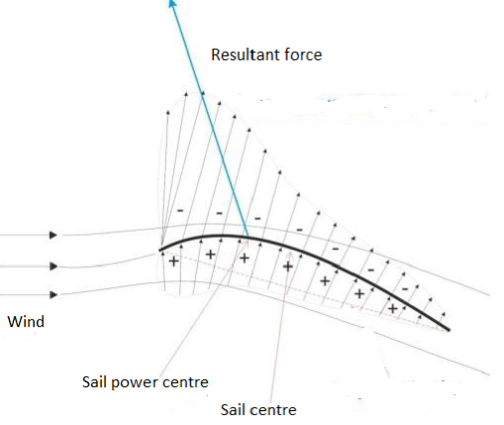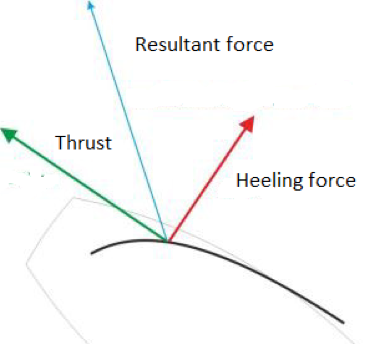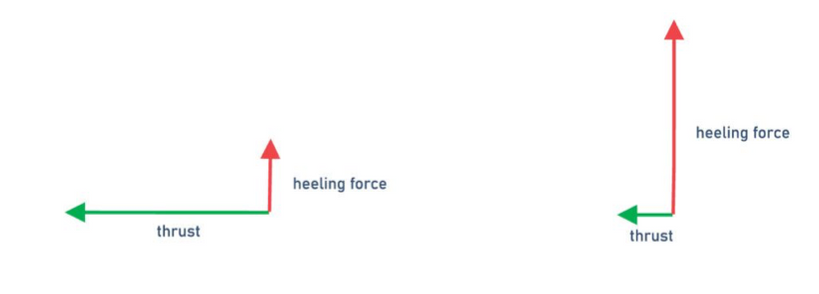Eduard Rodes
Barcelona
international coach
high performance sailing
English - Español
New rigging method for Optimist
Since the appearance of the Optimist in 1947, the possibilities of rigging this boat have always been very limited. It is perfectly understandable: the boat is designed exclusively for children´s use and its handling must be very simple. Equipped with a sprit sail, devoid of shrouds and spreaders, with few elements that allow you to configure the geometry of its sail - and all these parts are out of sailor´s hand reach during navigation. The simplicity of this boat alongside with very limited options to equip it, were the reason why its preparation for regattas, developed many years ago, has never undergone major changes.
The wood which the Optimists were originally built of, gave way to new materials, such as laminates in the hulls and foils and aluminium in the masts, but the preparation for regatta remained essentially the same. The new materials lasted longer and gave less maintenance, but they did not introduce significant changes in the possibilities of rigging.
It has not been until very recently that a new element has appeared, the ultra flexible sprits, which finally allows a change in the preparation of the Optimist. Sprits with a behaviour that makes possible a method of rigging and trimming, which until recently was unthinkable and that will make our boat faster and easier to handle.
tradicional technique
Until now, the way to prepare a boat consisted in providing it with a set of spars and a sail according to the weight of a sailor. Flexible spars and flat sails for the light ones, and rigid masts and more pocketed sails for the heaviest ones. Not many years ago appeared daggerboards of different degrees of rigidity. That increased considerably the rigging options, but surprisingly many sailors simply ignored this very important point.
The only existing technique to adapt sail´s power to the strong and/or gusty wind was to flatten it on its entire surface. The curvature that occurs in the mast due to the force of the wind makes a sail flatten due to the increased distance between the luff and the leech. That is absolutely true, it has always been so: a flat sail has less power than a deep sail, and it is easier to handle in strong wind.
But it has a drawback: by depowering our sail to be able to hold the boat in strong winds in the upwind course, we are also doing it for other courses, in which we want our sail to perform at its best. In addition, the boat will have less strength to pass the waves and less thrust in general. A high price, but there is no way avoid it.
before continuing, a bit of physics
Before explaining the new system let me explain a bit how a sail works.
A good coach will explain what you should do, how and when, but if you understand the physical reasons behind it, you will sail much better. For example, on the downwind course a coach tells you to take the boat heeling to windward. But if you don't know the reason of it, you won't know if you're heeling too much or not enough. Some believe that this is being done to reduce the wet surface of the hull, to reduce its friction. Or to take the sail higher, because there is more wind there...
If you understand that in reality this is needed to balance the boat and avoid that the rudder has to be all the time correcting a tendency to luff or gybe, you will get the perfect angle of heel, and thanks to this the rudder will work less and your boat will be faster. You only have to release the tiller for a moment on the downwind course and you will see if the boat continues straight, if it wants to luff or- on the contrary, it wants to gybe. And you will also see that balance, unlike that people believe, is achieved with a very moderate heeling.
But we were talking about rigging and how a sail works…
Look at this picture:
It shows the section of a sail and the power that is recorded in its entire length, from luff to leech. The + and - signs indicate the areas where the atmospheric pressure increases and decreases.You will notice that the area that produces the greatest force is the closest to the mast. The blue arrow is the result of all these forces and starts from the power centre of the sail, which never coincides with its geometric centre.
Now look at this picture.
The resultant force is broken down into two forces, that is what you will notice in your boat: the green one represents the thrust, which gives you speed and strength to pass the waves, and the red one is the one that produces the heeling.
In the picture below...
…it is easy to see that these forces are antagonistic: the greater the thrust, the less the heel, and the less thrust, the greater the heel. It is clear that we want the green arrow to be as large as possible because it will make the red one smaller. We will run more and heel less, won´t we?
In addition, the wind streams around the sail have two types of flow: laminar (parallel layers, no disruption) and turbulent (chaotic). The laminar flow is more effective, but its value is only around 20% of the sail chord, it is precisely in this area where the thrust force is concentrated and for this reason we are interested in maintaining its optimal shape.
new technique
The pictures show us that we want the front of the sail to be as powerful as possible. There are both speed and strength to pass the wave. Naturally, when there is a front there’s a back too; we cannot eliminate that area, which is the main cause of the heeling.
Thanks to the new spars that I mentioned above we can get much closer to the ideal than before - a sail always to perform at its best near the luff, and if you need to lose power, the sprit does it automatically by bending and opening the leech.
The secret is in combining a flexible sprit with a rigid mast. My advice is to have a mast as stiff as possible, no matter how light a sailor is. With this we achieve that the bending is minimal and consequently the area of the luff deforms as little as possible. In addition, we must keep in mind that this bending is always towards the stern and towards the leeward, which causes that a boat wants to luff in gusts and you have to stretch the rudder a lot to prevent it. When this happens it is equivalent to using the parking brake. This minimal bending of the mast, which is fully compensated by the way of rigging the sail explained HERE ensures that the area near the luff always remains in its best shape in any wind condition.
But, of course, it is still necessary to reduce the power of the sail when we have too much wind… and even more so if we are going to increase the performance of the luff area!
This is where the sprit comes into play, which is the main responsible of the leech tension. Recently introduced ultra-flex sprits manage to maintain sail geometry in light to medium winds, but allow the leech to open and empty the sail in gusts and strong winds. That will automatically reduce the heeling force, but the force that gives us speed and power to pass the waves will remain intact.
Thanks to this, in reaches and downwind courses your sail will always give you maximum performance. Not only the power of the entire sail is not permanently reduced, but it is also significantly increased at the front.
The use of a rigid mast has two additional great advantages. The first is very important: on windy days flexible masts need a very long rake to compensate for their curvature and displacement of the sail that occurs with the said curvature towards the stern. This means that in downwinds there is a clear tendency to have nose dives. With a stiff mast this practically disappears since less mast flexing can make a rake shorter. This simply lightens the bow and it wants to diveless.
The second advantage directly affects speed. If during a race the wind intensity increases, the rake of a stiff mast needs much less correction than the rake of a flexible one to maintain the balance between the force of a sail and the force of adaggerboard. We will notice that we brake the boat less with the rudder. It's even possible that we can compensate for that little bending simply by removing the daggerboard shock cord, the one that keeps the foil down in the daggerboard case. As the rear top end rises, the daggerboard centre moves back, so it will tend to balance again with the sail power centre and will allow us to continue obtaining maximum speed.
materials
One of the consequences of the arrival of the new spars and daggerboards is that the indicated sailor´s weight for each type of sails has increased substantially. This is because their natural power is used better. Before, for a 44 kg sailor the use of a “heavy” sail was recommended, while with the new system for a 46 kg sailor, a “medium” one would be the best option. An additional advantage of this is that by being able to use flatter sail models, the upwind angle is improved.
The brands that I recommend for each of the elements to equip your boat are the following:
- Spars. I have had the opportunity to try many... For me, the best and most reliable, the ones that will give you the expected stiffness and/or flex are those from Optimax and Optiparts. In other brands I have had unpleasant surprises.
- Foils. Without a doubt, N1 Foils. The best technology and the highest reliability. I have never met a daggerboard of this brand that was called “flexible” and turned out to be exactly the opposite. With other brands that has happened to me and more than once. A recent Spanish Champion that I had the privilege of training can attest to this ☺ The new daggerboard +1º Plus One Degree is a very important technological advance - it is auto orientable! A foil that gives you 2.5-3% higher upwind course than a normal one.
- Sails. JSail. It has the best quality/price ratio in competition sails. Its Blue model is extremely successful since many years and is the most copied sail in the world.
- Hulls. There are several brands on the market that offer high quality Optimist hulls, so I couldn't recommend one in particular. But I can give some advice when we want to be sure that we are buying a really good boat - it should not come from a charter. On some occasions I have seen boats that shipyard were building in a rush to deliver all orders made to rent them during a specific regatta such as world or continental championships, when they couldn´t dedicate enough time to each boat´s construction and it resulted in a lower than expected quality, translated into lower performance and/or durability.
In the following chart there’s the combination of elements to equip your Optimist that I recommend according to your weight.
And that’s all :-) I hope that this article helps you to reach the places in the podiums all we sailors dream of.





